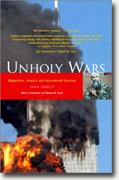Unholy Wars
John K. Cooley
book reviews:
· general fiction
· chick lit/romance
· sci-fi/fantasy
· graphic novels
· nonfiction
· audio books
· author interviews
· children's books @
curledupkids.com
· DVD reviews @
curledupdvd.com
newsletter
win books
buy online
links
home
for authors
& publishers
for reviewers

 |
Unholy Wars: Afghanistan, America and International Terrorism John K. Cooley Pluto Press Paperback 268 pages June 2002 |
|
John Cooley’s Unholy Wars is a detailed and systematic account of the manner in which U.S. policies and alliances in the Middle East went disastrously wrong and led to the creation of a form of Islamic militancy that now threatens to disrupt the peace, stability and political systems of several regions of the world.
The narrative starts in the late '70s, around the time of the Soviet occupation of Afghanistan. Before Afghanistan, the U.S. had generally relied on allies to carry out anti-communist tasks; its allies in the Mideast were Sadat of Egypt, King Hassan of Morocco, Kamal Adham of the Saudi Intelligence and the Shah of Iran. With these gentlemen (lovingly called the members of the “Safari Club”) around, the CIA could avoid dirtying its hands. After the Soviet occupation, however, a greater involvement on the part of the U.S. became necessary. The Carter administration started the process of providing arms and aid to a nascent Afghan moujahidin (resistance) along with initiating strong political and military alliances with several nations in the region. Cooley takes his readers on a tour of several nations and their leaders who were wooed by the CIA and the U.S. government. Heading the list: Anwar Sadat of Egypt. Sadat agreed to help train, equip and gather volunteers for the jihad against Soviets in Afghanistan in return for massive U.S. aid and to ease the antagonism that pro-Islamists felt at his signing a peace treaty with Israel. He paid a heavy price. The massive jihad effort that was mobilized in Egypt also transformed its unarmed political Islamic movements into terror outfits. Sadat lost his life and left a legacy of terrorism that is today a threat to Egypt’s socio-political stability. Next on the list is President Zia-ul-Haq, the military dictator of Pakistan. By virtue of its sharing a long border with Afghanistan, Pakistan had a key role in the supply and distribution of arms to the Afghan resistance. It is now common knowledge that this occurred almost exclusively via Pakistan’s intelligence agency, the ISI. ISI’s strong control over this war and the continuous and extensive arms influx for over a decade have not just been detrimental to Pakistan’s own internal polity but also to the stability of the region. Next Israel made a heavy contribution to the jihad effort by providing arms, training, military bases; however, the holy warriors became the pillars of the Islamist Hamas resistance that is threatening the peace process with Palestinians as never before. Others on the list are China, Saudi Arabia, Jordan and so on, each playing its own small part in the clandestine deals. Large parts of the book are devoted to how the funding for the Afghan jihad was obtained and the ramifications it had on the economies of the countries involved. Apart from the U.S. Army Special Operations Division, there was Saudi funding in addition to private Arab funding from zealots like Osama bin Laden. The Bank of Credit and Commerce International (BCCI) that helped Saudis and CIA finance the jihad and eventually collapsed as a result sunk millions of dollars of money invested by middle class investors of Muslim countries. Finances also poured in from narcotic dealers along the Pakistan-Afghanistan border and further strengthened the poppy cultivation-drug-weapons syndicate in both countries. The socio-political ramifications of the Afghan jihad are now before us all to see. The brand of imported extremism and terrorism that had its genesis in the warriors trained in different countries to fight Soviet forces now exists everywhere, from the Philippines to the United States. This perhaps is the legacy of fighting a holy war by unholy means.
|
|
|
|
 Click here to learn more about this month's sponsor! |
|
| fiction · sf/f · comic books · nonfiction · audio newsletter · free book contest · buy books online review index · links · · authors & publishers reviewers |
|
| site by ELBO Computing Resources, Inc. | |
 As a news correspondent John Cooley spent decades in the Middle East, interacting with numerous politicians, administrators and diplomats and researching thoroughly the policies of the governments of both this region and the U.S. during the period of 1979-89. With this book, he examines all the “unholy” events that were set in motion as a consequence.
As a news correspondent John Cooley spent decades in the Middle East, interacting with numerous politicians, administrators and diplomats and researching thoroughly the policies of the governments of both this region and the U.S. during the period of 1979-89. With this book, he examines all the “unholy” events that were set in motion as a consequence.